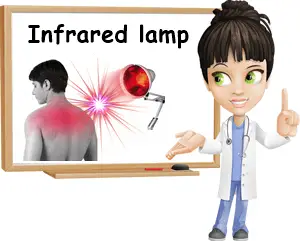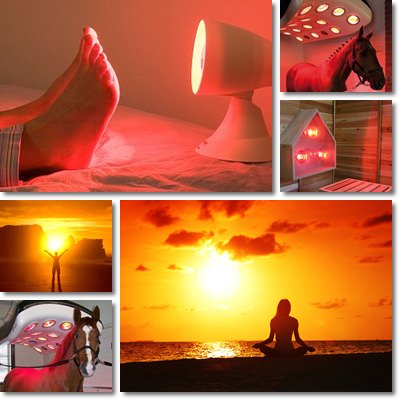Last winter I had a resilient ache in my neck caused by feeling too cold. Every time I had to get out of the house, even for a very short time, my neck would start to ache more, despite being all covered up. As soon as I would get inside and warm up well, the ache would decrease considerably. Because I couldn’t avoid the winter cold and my ache was becoming too much to deal with at times, I decided to get myself a small infrared heating lamp to heat the sore muscle in my neck and get some relief after a month of suffering. And it worked.
I knew very little about infrared lamp heating therapy and did not expect much improvement, but after using it for only 10 minutes, I no longer had a stiff neck and regained most of my mobility. My ache improved considerably so I used the lamp to warm up my feet when they were too cold and my knees when they hurt from too much humidity. I found great relief in infrared heating therapy and continued to use the lamp for various cold-related aches and cramps with excellent results. What I liked best was that aches and cramps disappeared completely after as little as one or two uses.

What is an infrared lamp and what does it do? Infrared heating lamps are electrical lamps that emit infrared radiation for the purpose of heating. Using them to treat various aches and pains caused by feeling cold, high humidity etc. is known as infrared heating therapy. They are the same lamps used in raising baby chickens, ducklings and other poultry incubated and hatched in an incubator, but also lizards, tortoises etc.
What does an infrared lamp look like? Infrared lamps emit infrared radiation, hence their name. This radiation is identical to that from sunshine and produces similar warming effects. Generally, these lamps produce a red light, but they may also come in warm yellow to mimic sunshine. Most lamps for therapeutic use range from 100 to 300 watts, but bigger models that can cover areas as large as the entire back can work their way up to 650 watts or more. Depending on the brand and model, they may be small enough to grip with one hand or as large as 7 kg and over 1 meter in height, with a cord as long as 3 meters that allows for better access to a socket.
How does an infrared lamp work? Infrared lamps contain an infrared bulb that produces heat. By its very nature, infrared radiation reaches deep into the skin, dilating blood vessels and improving circulation, thus warming us up. In my experience, the effects are similar to sitting in the sun and feeling its warm rays penetrate the skin and warming you from the inside, muscles, bones, joints, cartilages and all. If used correctly, it can be quite relaxing. Depending on its size, a lamp may cover as little as the back of the neck and head, one shoulder or the hands or as much as the entire back.
How to use an infrared lamp. It is important to always use infrared lamps and other similar products as specified in the instructions to avoid unnecessary side effects and fully enjoy the health benefits they provide. When it comes to infrared lamps, make sure you limit use to 10-12 minutes and avoid looking directly into the light. Keep the lamp at the recommended distance from the skin to avoid burns. I have a 100 watt infrared desk lamp that I keep about 40-60 cm away from the skin. Also remember the lamp case and the bulb heat up considerably so avoid touching them when they get hot and allow them to cool down after use before you put the lamp away.

Health benefits
What is infrared lamp heating therapy good for? Using an infrared lamp can provide the following benefits:
1) Improve blood circulation. The heat from infrared lamps manages to reach our blood vessels and dilate them, leading to better blood circulation.
2) Relax muscles. The improved blood circulation helps relieve tension and relax muscles. This contributes to fewer muscle cramps, less tension and even pain relief.
3) Help oxygenate tissue. The infrared radiation of the lamp reaches deep into the skin, warming up tissues and blood vessels and contributing to better oxygenation.
4) Pain relief. Infrared heating therapy can help relieve some of the pain caused by various muscle, bone or joint problems. This is a result of both the warming effects and improved blood circulation which relieve tension, allow muscles to relax and reduce joint stiffness, at the same time improving mobility.
5) Faster healing. By improving blood circulation, the infrared radiation from the lamp allows for muscles to be well-nourished and repair themselves. The nutrients we absorb at the intestinal level are key elements for tissue repair.
6) Reduce stress. Just as lying in the sun gives us a pleasant feeling of calm and serenity, so using an infrared lamp can relieve stress caused by various pains and aches and help us relax.
Potential uses
What do you use an infrared lamp for? Uses cover a variety of ailments and conditions such as:
1) Muscle aches and cramps.
2) Muscle tension.
3) Muscle contractions.
4) Cervical neck pain.
5) Stiff joints.
6) Cold hands and feet.
7) Abdominal cramps (also period cramps and cramps caused by sudden exposure to cold).
8) Headaches caused by cold air or wind blowing in our face or on the head.
Other uses. Infrared lamps are said to improve acne by helping clear skin of impurities (reducing blemishes, unclogging pores). Some people find this therapy offers some relief when it comes to throat, nose and even ear infections such as otitis. Infrared lamps may be used for fungal infections behind the ears caused by dampness and can help with symptoms, but are not a substitute for antifungal treatment. Lastly, the heat therapy may help alleviate period cramps and relieve headaches.
Side effects and risks
The potential risks and side effects of using an infrared lamp include:
1) Eye injury may occur when we look at the infrared light directly so if we want to use the lamp on the face area for a couple of minutes, it might be best to close our eyes or wear something over them (a sleeping eye mask).
2) Sweating from the heat. This is not necessarily dangerous, but it may worsen dehydration or cause unpleasant reactions in overly-sensitive skin, potentially irritating it.
3) Redness, irritation. Proximity to the lamp or prolonged use (more than 10-15 minutes) can overheat the skin and cause it to become red, irritated, inflamed. These are also common effects of spending too much time roasting in the sun.
4) Burns or blistering. This is a more severe side effect and can only occur if we intentionally keep using an infrared lamp after we start feeling the heat burning our skin. It’s no different from taking in too much sun at once.
5) Allergic reaction in particularly sensitive people. Producers warn that it is possible for some people to experience a sort of allergic reaction to the infrared radiation heat which makes it even more important to limit use to recommended time, especially when using the lamp for the first time.
